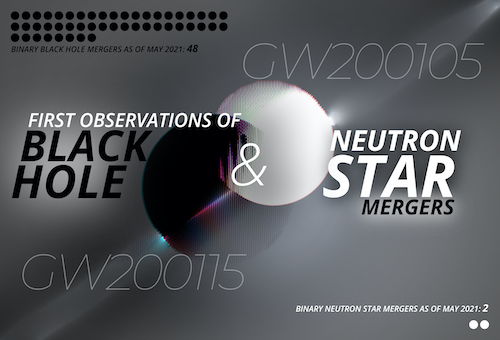On 29 June 2021, the LIGO, Virgo, and KAGRA collaborations announced the discovery of GW200105 and GW200115 – the first confirmed observations of neutron star-black hole (NSBH) binaries. The first binary, GW200105, consists of a 8.9 solar mass black hole and a 1.9 solar mass neutron star. The second binary, GW200115, is a 5.7 solar mass black hole and 1.5 solar mass neutron star. No electromagnetic counterparts were detected for either system.

[Artist’s illustration of a merging black hole and neutron star. Credit: Carl Knox, OzGrav/Swinburne University.]
Publications & Documentation
- Publication: Observation of gravitational waves from two neutron star-black hole coalescences (published in the Astrophysical Journal Letters).
[download from journal website] [LIGO DCC pdf link] - LSC Press Release.
- LIGO Lab news item
- Science Summary flyer [pdf flyer].
- Data release for GW200105 and GW200115 (Gravitational Wave Open Science Center/GWOSC).
- Fact sheet for GW200105 and GW200115 [translations available here]
- Known stellar mass black holes interactive graphic
- See the main ligo.org detection page for further resources.

Image from a numerical simulation representing the coalescence of a black hole-neutron star system (NSBH). This image is taken from the numerical simulation shown at the right. It represents a system consistent with the observed parameters for GW200115, one of the first two confirmed NSBH systems. Gravitational waves are represented in blue. The density of the neutron star is represented in yellow to orange (low to high densities). An image showing only the inset can be found here.
[Credit: S.V.Chaurasia (Stockholm University), T. Dietrich (Potsdam University and Max Planck Institute for Gravitational Physics), N. Fischer, S. Ossokine, H. Pfeiffer (Max Planck Institute for Gravitational Physics).]
Numerical simulation showing gravitational-waves from a neutron star-black hole binary consistent with GW200105. The black hole is roughly 4.7 times the mass of the neutron star and neither is spinning. Due to the significant difference in mass, the neutron star barely suffers any disruption until the end and is engulfed by the black hole almost entirely.
[Credit: Deborah Ferguson (UT Ausitn), Bhavesh Khamesra (Georgia Tech), and Karan Jani (Vanderbilt)]
Images & Videos

Still image from the above numerical simulation, showing the tidal disruption of a neutron star by a black hole. As the neutron star approaches the black hole, the tidal forces overpower the self-gravity of the neutron star, leading to its disruption. In this simulation, the black hole is twice as massive as the neutron star and neither is spinning. (While the two detected NSBH systems reported here do not show evidence for tidal disruption, this simulation illustrates the tidal disruption process in a NSBH binary with different masses.)
[Image credit: Deborah Ferguson (UT Ausitn), Bhavesh Khamesra (Georgia Tech), and Karan Jani (Vanderbilt)]
Numerical simulation showing the coalescence of a black hole-neutron star system (NSBH). The animation represents a system consistent with the observed parameters for GW200115, one of the first two confirmed NSBH systems. The black hole mass was chosen to be 6.1 solar masses and the neutron star mass was set to 1.4 solar masses. Both objects were non-spinning. Due to this parameter choice, and in agreement with the non-detection of an electromagnetic counterpart, the neutron star is swallowed by the black hole without being tidally disrupted. Therefore, no noticeable accretion disk forms around the black hole during the merger process. Gravitational waves are represented in blue. The density of the neutron star is represented in yellow to orange (low to high densities). We also show the gravitational wave strain in the bottom part of the video, indicating the time evolution.
[Image credit: S.V.Chaurasia (Stockholm University), T. Dietrich (Potsdam University and Max Planck Institute for Gravitational Physics), N. Fischer, S. Ossokine, H. Pfeiffer (Max Planck Institute for Gravitational Physics).]

Image from a numerical simulation in which the neutron star gets tidally disrupted during the merger process. This is similar to the above image, but for a system with different masses and for which the tidal disruption of the neutron star is visible. This illustrates the tidal disruption process, which is believed to have not occurred in the two observed systems reported here. An image showing only the inset can be found here.
[Image credit: S.V.Chaurasia (Stockholm University), T. Dietrich (Potsdam University and Max Planck Institute for Gravitational Physics), N. Fischer, S. Ossokine, H. Pfeiffer (Max Planck Institute for Gravitational Physics), T. Vu.]

Masses in the stellar graveyard. This graphic shows the masses of black holes detected through electromagnetic observations (purple), black holes measured by gravitational-wave observations (blue), neutron stars measured with electromagnetic observations (yellow), and neutron stars detected through gravitational waves (orange). The two newly reported neutron star-black hole binaries are highlighted in the middle of the graphic. See an interactive version of this graphic here.
[Image credit: LIGO-Virgo/Northwestern U./Frank Elavsky & Aaron Geller]
Numerical simulation of the tidal disruption of a neutron star as it merges with a black hole. As the neutron star approaches the black hole, the tidal forces overpower the self-gravity of the neutron star, leading to its disruption. In this simulation, the black hole is twice as massive as the neutron star and neither is spinning. (While the two detected NSBH systems reported here do not show evidence for tidal disruption, this simulation illustrates the tidal disruption process in a NSBH binary with different masses.)
[Credit: Deborah Ferguson (UT Ausitn), Bhavesh Khamesra (Georgia Tech), and Karan Jani (Vanderbilt)]

Artist’s rendition of gravitational waves generated by a neutron star-black hole binary.
[Image credit: Mark Myers, OzGrav/Swinburne U.]

Artistic rendition of a neutron star merging with a black hole.
[Image credit: Soheb Mandhai/LIGO-India]

